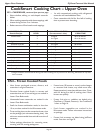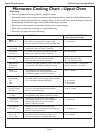
CJ Oven Care and Use Manual
Basics for Microwave Mode – Upper Oven
Utensils
Recommended for Microwave Mode
• Glass ceramic (Pyroceram
®
, such as CorningWare
®
)
• Heat-safe glass (i.e. Pyrex
®
)
• Microwave-safe plastics
• Paper plates, paper cups
• Microwave-safe pottery, stoneware, porcelain
• Browning dish: follow manufacturer's directions for
preheating dish.
• Metal Bakeware
Tips
• Microwave energy may cause some arcing between
metal objects. Small amounts of arcing are neither
harmful nor hazardous.
• To check whether a dish or mug is safe to use in
this mode, put empty item on rack and heat on
High for 30 seconds. If it becomes very hot, do not
use it.
Not Recommended for Microwave Mode
• Non-heat resistant glass
• Food carton with metal handle
• Non-microwave-safe plastics (i.e. margarine tubs)
• Styrofoam containers or cups
• Metal or non-microwaveable plastic commuter
beverage containers
• Recycled paper products (i.e. brown shopping bags)
• Metal twist ties
• Food storage bags
Recommended Disposable Covers
• Paper towels (See Page 5)
• Wax paper
• Microwave-safe plastic wraps (vent so steam
escapes). Do not allow plastic wrap to touch food.
• Parchment paper
Food Selection
• Quantity - The cooking time is dependent on the
amount of food in the oven.
• Content – The amount of fat, sugar and liquid in
the food affects the cooking time. For example,
eggs, cheese, mayonnaise, etc., cook very quickly.
• Density – A non-porous food, such as roast, takes
longer to cook than a porous food such as bread.
• Shape and Size –Uniform shapes and sizes cook
more evenly.
Cooking Techniques
• Arranging – Place food in a circular pattern with
the thickest areas toward the outside of dish.
• Covering – Most foods cook and reheat more
evenly when covered.
• Piercing – Foods with skins or membranes must
be pierced, scored or have a strip of skin peeld be-
fore cooking to allow steam to escape.
• Shielding – Cover thinner areas of food with foil
to prevent over-cooking or defrosting too quickly,
such as chicken drumsticks. Allow one inch of space
between foil and surfaces. Do not wrap baking po-
tatoes in foil.
• Stirring and Turning – Stir foods from the outer
edges toward center of utensil or turn food over
once during cooking. Stir liquids before and after
heating to help prevent “eruption.”
• Standing Time – It is necessary to allow food to
stand to complete cooking.
Guide to Power Levels (
Rated 750W)
HI (100%) Poultry, fish, fresh and frozen vegetables,
casseroles, boil water, pop corn, pudding.
9 ( 90%) Reheat rice and pasta.
8 ( 80%) Reheat precooked food, seafood.
7 ( 70%) Cheese entrees.
6 ( 60%) Scrambled eggs, cakes.
5 (50%) Custards, pasta, tender meats: beef,
ham, lamb, pork, veal.
4 (40%) Slow cook entrees and less tender
meats covered with liquid.
3 (30%) Defrost uncooked or precooked food,
simmer stews and sauces.
2 (20%) Reheat pancakes, tortillas, French toast.
1 (10%) Hold entrees at serving temperatures.
Upper Oven Features
Page 24
Refer to Pages 4 and 5 for microwave safety precautions.


















